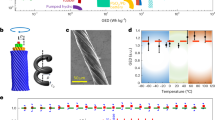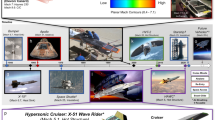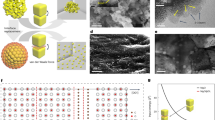Abstract
Fast development of space technologies poses a strong challenge for elastic materials, which need to be not only lightweight, strong and compliant, but also able to maintain stable elasticity over a wide temperature range1,2,3,4. Here we report a lightweight magnesium–scandium strain glass alloy (Mg with 21.3 at.% Sc) that meets this challenge. This alloy is as light (density ~2 g cm–3) and compliant as organic-based materials5,6,7 like bones and glass fibre reinforced plastics, but in contrast with those materials, it possesses a nearly temperature-independent (or Elinvar-type), ultralow Young’s modulus (~20–23 GPa) over a wide temperature range from room temperature down to 123 K; a higher yield strength of ~200–270 MPa; and a long fatigue life of over one million cycles. As a result, it exhibits a relatively high, temperature-independent elastic energy density of ~0.5 kJ kg–1 among known materials at a moderate stress level of 200 MPa. We show that its exceptional properties stem from a strain glass transition, and the Elinvar-type elasticity originates from its moderate elastic softening effect cancelling out the ever-present elastic hardening. Our findings provide insight into designing materials that possess unconventional and technologically important elastic properties.
This is a preview of subscription content, access via your institution
Access options
Access Nature and 54 other Nature Portfolio journals
Get Nature+, our best-value online-access subscription
$29.99 / 30 days
cancel any time
Subscribe to this journal
Receive 12 print issues and online access
$259.00 per year
only $21.58 per issue
Buy this article
- Purchase on Springer Link
- Instant access to full article PDF
Prices may be subject to local taxes which are calculated during checkout





Similar content being viewed by others
Data availability
All data generated or analysed during this study are included in the published article and Supplementary Information and are available from the corresponding authors upon request.
References
Xia, J. et al. Iron-based superelastic alloys with near-constant critical stress temperature dependence. Science 369, 855–858 (2020).
Scott, A. S. & Sherwood, B. Out of This World: The New Field of Space Architecture (American Institute of Aeronautics and Astronautics, 2009).
Lesser, D. H., Logan, G. & Christopher, K. W. Active optical correctors for large inflatable telescopes. IEEE Trans. Terahertz Sci. Technol. 9, 409–416 (2019).
NASA Science. Solar System Exploration http://solarsystem.nasa.gov/resources/925/solar-systemand-beyond-poster-set/ (2019).
Tagliaferri, V., Caprino, G. & Diterlizzi, A. Effect of drilling parameters on the finish and mechanical properties of GFRP composites. Int. J. Mach. Tool. Man. 30, 77–84 (1990).
Ramesh, M., Palanikumar, K. & Reddy, K. H. Mechanical property evaluation of sisal–jute–glass fiber reinforced polyester composites. Compos. B Eng. 48, 1–9 (2013).
Chen, Q. & Thouas, G. A. Metallic implant biomaterials. Mat. Sci. Eng. R 87, 1–57 (2015).
Ashby, M. F. Materials Selection in Mechanical Design 4th edn (Elsevier, 2011).
Lecce, L. & Concilio, A. (eds) Shape Memory Alloy Engineering: for Aerospace, Structural and Biomedical Applications (Elsevier, 2015).
Suh, B. C., Shim, M. S., Shin, K. S. & Kim, N. J. Current issues in magnesium sheet alloys: where do we go from here? Scr. Mater. 84–85, 1–6 (2014).
Huang, X., Suzuki, K., Chino, Y. & Mabuchi, M. Texture and stretch formability of AZ61 and AM60 magnesium alloy sheets processed by high-temperature rolling. J. Alloy Compd. 632, 94–102 (2015).
Bian, M. Z. et al. A heat-treatable Mg–Al–Ca–Mn–Zn sheet alloy with good room temperature formability. Scr. Mater. 138, 151–155 (2017).
Bhattacharjee, T. et al. High strength and formable Mg–6.2Zn–0.5Zr–0.2Ca alloy sheet processed by twin roll casting. Mat. Sci. Eng. A 609, 154–160 (2014).
Yuasa, M., Miyazawa, N., Hayashi, M., Mabuchi, M. & Chino, Y. Effects of group II elements on the cold stretch formability of Mg–Zn alloys. Acta Mater. 83, 294–303 (2015).
Huang, X., Suzuki, K., Chino, Y. & Mabuchi, M. Influence of aluminum content on the texture and sheet formability of AM series magnesium alloys. Mat. Sci. Eng. A 633, 144–153 (2015).
Zou, Y. et al. Texture evolution and their effects on the mechanical properties of duplex Mg–Li alloy. J. Alloy Compd. 669, 72–78 (2016).
Zou, Y. et al. Deformation mode transition of Mg3Li alloy: an in situ neutron diffraction study. J. Alloy Compd. 685, 331–336 (2016).
Askariani, S. A. & Pishbin, S. M. H. Hot deformation behavior of Mg-4Li-1Al alloy via hot compression tests. J. Alloy Compd. 688, 1058–1065 (2016).
Kada, S. R. et al. In-situ X-ray diffraction studies of slip and twinning in the presence of precipitates in AZ91 alloy. Acta Mater. 119, 145–156 (2016).
Agnew, S. R., Yoo, M. H. & Tomé, C. N. Application of texture simulation to understanding mechanical behavior of Mg and solid solution alloys containing Li or Y. Acta Mater. 49, 4277–4289 (2011).
Barnett, M. R. et al. Influence of grain size on the compressive deformation of wrought Mg–3Al–1Zn. Acta Mater. 52, 5093–5103 (2004).
Bohlen, J. et al. The texture and anisotropy of magnesium–zinc–rare earth alloy sheets. Acta Mater. 55, 2101–2112 (2007).
Newnham, R. E. Properties of Materials: Anisotropy, Symmetry, Structure (Oxford Univ. Press, 2004).
Ogawa, Y., Ando, D., Sutou, Y. & Koike, J. A lightweight shape-memory magnesium alloy. Science 353, 368–370 (2016).
Otsuka, K. & Wayman, C. M. Shape Memory Materials (Cambridge Univ. Press, 1998).
Saito, T. et al. Multifunctional alloys obtained via a dislocation-free plastic deformation mechanism. Science 300, 464–467 (2003).
Zhu, J. et al. Making metals linear super-elastic with ultralow modulus and nearly zero hysteresis. Mater. Horiz. 6, 515–523 (2019).
Herbert, E. G., Pharr, G. M., Oliver, W. C., Lucas, B. N. & Hay, J. L. On the measurement of stress–strain curves by spherical indentation. Thin Solid Films 398, 331–335 (2001).
Guo, Y., Xie, J., Zheng, W. & Li, J. Effects of steel slag as fine aggregate on static and impact behaviours of concrete. Constr. Build. Mater. 192, 194–201 (2018).
Henry S. D. et al. Fatigue Data Book: Light Structural Alloys (ASM International, 1995).
Ferdous, W. et al. Testing and modelling the fatigue behaviour of GFRP composites – effect of stress level, stress concentration and frequency. Eng. Sci. Technol. 23, 1223–1232 (2020).
Merati, A. A study of nucleation and fatigue behavior of an aerospace aluminum alloy 2024-T3. Int. J. Fatigue 27, 33–44 (2005).
Guillaume, C. E. Discovery of the anomaly. Proc. Phys. Soc. 32, 374–404 (1920).
Liu, C., Ji, Y. & Ren, X. Strain glass and novel properties. Shape Mem. Superelasticity 5, 299–312 (2019).
Zhou, Y. et al. Direct evidence for local symmetry breaking during a strain glass transition. Phys. Rev. Lett. 112, 025701 (2014).
Wang, Y. et al. Strain glass transition in a multifunctional β-type Ti alloy. Sci. Rep. 4, 3995 (2014).
Ogawa, Y., Ando, D., Sutou, Y., Somekawa, H. & Koike, J. Martensitic transformation in a β-type Mg–Sc alloy. Shape Mem. Superelasticity 4, 167–173 (2018).
Zhang, L., Wang, D. & Ren, X. A new mechanism for low and temperature-independent elastic modulus. Sci. Rep. 5, 11477 (2015).
Zeng, Z. et al. Magnesium extrusion alloys: a review of developments and prospects. Int. Mater. Rev. 64, 27–62 (2019).
Lord, J. D. & Morrell, R. M. Elastic modulus measurement—obtaining reliable data from the tensile test. Metrologia 47, S41 (2010).
Hao, Y. L. et al. Elastic deformation behaviour of Ti–24Nb–4Zr–7.9Sn for biomedical applications. Acta Biomater. 3, 277–286 (2007).
Acknowledgements
This work was supported by the National Natural Science Foundation of China (51701150, 51831006, 52071257, 51901243) and the National 111 Project 2.0 (BP2018008).
Author information
Authors and Affiliations
Contributions
Y.J. and X.R. conceived the idea. C.L. and Y.J. designed the project. C.L., J.T., M.H. and T.M. fabricated the samples. C.L., J.T. and P.L. performed experiments, and C.L. analysed the results with all the authors. D.W. helped analyse the mechanism of the Elinvar effect. C.L., Y.J. and X.R. wrote the manuscript with input from all the authors.
Corresponding authors
Ethics declarations
Competing interests
The authors declare no competing interests.
Peer review
Peer review information
Nature Materials thanks Ibrahim Karaman and the other, anonymous, reviewer(s) for their contribution to the peer review of this work.
Additional information
Publisher’s note Springer Nature remains neutral with regard to jurisdictional claims in published maps and institutional affiliations.
Supplementary information
Supplementary Information
Supplementary Figs. 1–9 and Table 1.
Rights and permissions
About this article
Cite this article
Liu, C., Ji, Y., Tang, J. et al. A lightweight strain glass alloy showing nearly temperature-independent low modulus and high strength. Nat. Mater. 21, 1003–1007 (2022). https://doi.org/10.1038/s41563-022-01298-y
Received:
Accepted:
Published:
Issue Date:
DOI: https://doi.org/10.1038/s41563-022-01298-y
This article is cited by
-
A review on the rational design and fabrication of nanosized high-entropy materials
Nano Research (2023)
-
Mixed-Alkali Effect on Thermal Property and Elastic Behavior in Borosilicate Glasses
Journal of Wuhan University of Technology-Mater. Sci. Ed. (2023)
-
Non-conventional Strain Glasses
Shape Memory and Superelasticity (2023)
-
Heterogeneous Structure-Induced Excellent Functional Properties in Shape Memory Alloys: A Review
JOM (2023)



